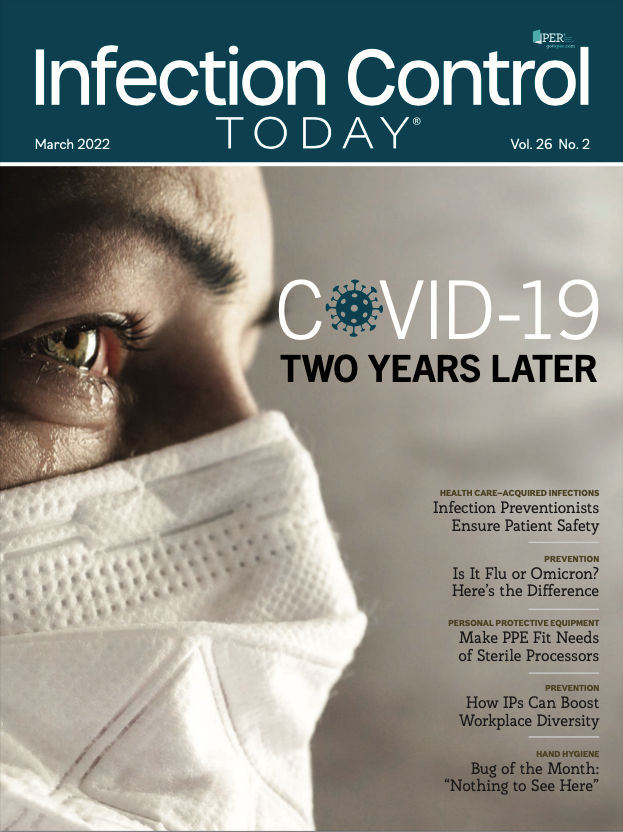Flu or Omicron? Diagnosis Must be Done Quickly
The highly transmissible and dominant Omicron variant of COVID-19 places added pressure on infection preventionists and other clinicians to determine just what they’re dealing with.
As the Omicron variant of COVID-19 surges to record-breaking levels in the United States in terms of infections and hospitalizations it might be easy for the public to overlook that influenza has also spiked in recent weeks. The flu spike seems to have slowed in the last 2 weeks (see chart below) according to the Centers for Disease Control and Prevention (CDC), but not enough so that infection preventionists and other health care professionals don’t have to deal with the muddle of possible coinfection. Does the patient presenting with respiratory problems have influenza or 1 of the COVID-19 variants? Perhaps it’s just the common cold or allergies?
Being able to interpret early signs of disease is vital toward taking necessary steps to recovery and mitigation—receiving laboratory or at-home test result confirmation, referring to a clinician, taking necessary treatment, and possibly isolating from at-risk persons. While limited national testing availability and stunted turnaround time has plagued the US response to COVID-19 outbreaks since March 2020, massive data collection has given experts a more refined understanding of what is early signs of COVID-19, versus possibly the flu or otherwise.
Here is CDC guidance for identifying signs and symptoms, time from exposure to infection, and duration of illness for both COVID-19 and the flu.
Signs and Symptoms of COVID-19 and Influenza
While both diseases can present asymptomatically, the respiratory viruses share about a dozen common symptoms:
- Change in or loss of smell or taste
- Chills
- Congestion
- Cough
- Diarrhea
- Fatigue
- Fever
- Headache
- Muscle pain or body aches
- Shortness of breath
- Sore throat
- Vomiting
Persons with the flu often feel some or all of the above symptoms—with change in or loss of smell or taste being more frequently reported among patients with COVID-19. Young children with the flu are more susceptible to diarrhea than older patients.
Relative to the common cold, these symptoms occur abruptly in infected flu patients, with the below frequency:
- Chills: Fairly common
- Congestion: Sometimes
- Cough: Common
- Fatigue: Usual
- Fever: Common for 3-4 days
- Headache: Common
- Sore throat: Sometimes
Separately, COVID-19 cases include signs indicating need for emergent care that may sometimes differentiate from early flu signs and symptoms, including:
- Trouble breathing
- Persistent chest pain or pressure
- New confusion
- Inability to wake or stay awake
- Pale, gray, or blue-colored skin, lips, or nail beds
Time From Exposure to Infection
Both COVID-19 and flu can become apparent or symptomatic as soon as 1 day post-infection. However, COVID-19 symptoms have frequently presented later in patients than symptoms of the flu—a difference of 2 to 14 days versus 1 to 4 days post-infection, respectively.
However, experts have observed that the highly transmissible and dominant Omicron variant of SARS-CoV-2 has been associated with expedited time from infection to presenting symptoms, and therefore, risk of spreading disease. This further stresses the need for identifying COVID-19 versus flu cases.
Duration of Illness
Flu is often associated with a recovery time anywhere between a few days to 2 weeks, notwithstanding severe cases or development of complications including sinus infections, pneumonia, myocarditis, encephalitis, myositis, organ failure, sepsis or more. Patients with the flu are also at greater risk of secondary bacterial infections than those with COVID-19, according to the CDC.
COVID-19 illness duration, unfortunately, is an interpretation still being researched. Cases of “long COVID” have been observed to last weeks to months following infection, regardless of patients’ disease severity or symptoms. Patients additionally face risk of complications including blood clots in the veins and arteries of the lungs, heart, legs, or brain, and development of multisystem inflammatory syndrome (MIS), any of which could warrant hospitalization and continued care.
Duration of contagious flu spread can begin as early as a full day before any symptom onset, and can last from 3 to 7 days for most patients, dependent on their age and health—older patients, infants, and those with weakened immune systems may be contagious for longer than a week.
COVID-19 can be spread 2 days prior to any symptom onset, and patients remain contagious for ≥10 days after apparent symptoms and/or a positive test result, per CDC—regardless of asymptomatic status. Those with severe disease and/or weakened immune systems may be contagious for ≥20 days.
This article was originally published on HCPLive.
Source: Centers for Disease Control and Prevention


Our Understanding of Immune Issues Is Evolving: Here Are 5 Reasons Why
October 25th 2024The past 5 years in medicine have seen significant advances in RNA vaccines, understanding immune dysregulation, and improved interspecialty communication, promising better disease eradication and tailored treatments.